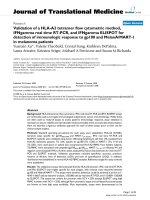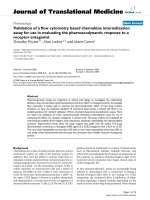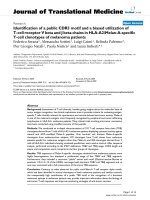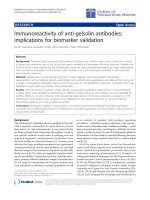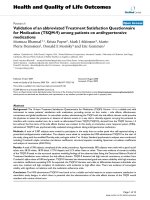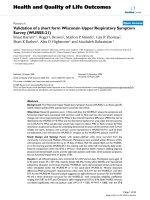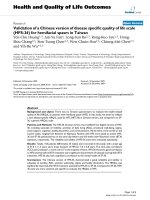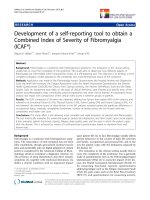báo cáo hóa học: " Validation of a core outcome measure for palliative care in Africa: the APCA African Palliative Outcome Scale" pptx
Bạn đang xem bản rút gọn của tài liệu. Xem và tải ngay bản đầy đủ của tài liệu tại đây (288.85 KB, 9 trang )
RESEARC H Open Access
Validation of a core outcome measure for
palliative care in Africa: the APCA African
Palliative Outcome Scale
Richard Harding
1*
, Lucy Selman
1
, Godfrey Agupio
2
, Natalya Dinat
3
, Julia Downing
4
, Liz Gwyther
5
, Thandi Mashao
6
,
Keletso Mmoledi
3
, Tony Moll
7
, Lydia Mpanga Sebuyira
8
, Barbara Panjatovic
9
, Irene J Higginson
1
Abstract
Background: Despite the burden of progressive incurable disease in Africa, there is almost no evidence on patient
care or outcomes. A primary reason has been the lack of appropriate locally-validated outcome tools. This study
aimed to validate a multidimensional scale (the APCA African Palliative Outcome Scale) in a multi-centred
international study.
Methods: Validation was conducted across 5 African services and in 3 phases: Phase 1. Face validity: content
analysis of qualitative interviews and cognitive interviewing of POS; Phase 2. Construct validity: correlation of POS
with Missoula-Vitas Quality of Life Index (Spearman’s rank tests); Phase 3. Internal consistency (Cronbach’s alpha
calculated twice using 2 datasets), test-retest reliability (intraclass correlation coefficients calculated for 2 time
points) and time to complete (calculated twice using 2 datasets).
Results: The validation involved 682 patients and 437 family carers, interviewed in 8 different languages. Phase 1.
Qualitative interviews (N = 90 patients; N = 38 carers) showed POS items mapped well onto identified needs;
cognitive interviews (N = 73 patients; N = 29 carers) demonstrated good interpretation; Phase 2. POS-MVQoLI
Spearman’s rank correlations were low-moderate as expected (N = 285); Phase 3. (N = 307, 2nd assessment mean
21.2 hours after first, SD 7.2) Cronbach’s Alpha was 0.6 on both datasets, indicating expected moderate internal
consistency; test-retest found high intra-class correlation coefficients for all items (0.78-0.89); median time to
complete 7 mins, reducing to 5 mins at second visit.
Conclusions: The APCA African POS has sound psychometric properties, is well comprehended and brief to use.
Application of this tool offers the opportunity to at last address the omissions of palliative care research in Africa.
Background
The lack of clinical and research activity to enhance care
of the dying among those HIV-infected is a global chal-
lenge. Despite two million deaths during 2007, with
emerging international data reporting high mortality
even as access to therapy increases, very little scientific
attention is paid to improving the experience of death
and dying [1].
The burden of progressive, life-limiting disease in Sub-
Saharan Africa is reflected in the epidemiolog y of HIV
[2,3] and cancer [4]. In sub-Saharan Africa during 2007
there were 22.5 million people living with HIV infection;
1.7 million adults and children became infected with
HIV; and 1.6 million died of AIDS [1]. Based on GLO-
BOCAN 2002 cancer rates and UN population predic-
tions, there were an estimated 7.6 million new cancer
cases and 6 million deaths from cancer in Africa in
2007 [5], and malignancies are a common presentation
of HIV progression. The burden of other progressive
non-malignant diseases is unknown.
Significant advances have been achieved in African
palliative care pro vision to manage the highly prevalent
and burdensome problems experienced by those with
incurable terminal disease. However, there is very little
* Correspondence: k
1
King’s College London, Dept Palliative Care, Policy & Rehabilitation, King’ s
College London, Weston Education Centre, Cutcombe Road, Denmark Hill,
London SE5 9RJ, UK
Harding et al. Health and Quality of Life Outcomes 2010, 8:10
/>© 2010 Harding et al; licensee BioMed Central Ltd. This is an Open Access article distributed under the terms of the Creative Commons
Attribution License ( which permits unrestricted use, distribution, and repro duction in
any medium, pro vided the original work is properly cited.
evidence for o utcomes of effectiveness of this care, a
common problem in developing country contexts, where
health systems research is under-funded [6,7]. A primary
reason for this dearth of evidence is the lack of appro-
priate and validated outcome tools [8], among other
logistical and methodological challenges in this setting
and population [9].
Advanced care clinicians in Africa identified the need
for appropriate outcome tool s [10], and suggested that
these tools should be appropriate for both HIV and can-
cer patients, address family and patient outcomes, be
locally validated [11], and be relevant to all stages of the
disease trajectory [12]. In addition to validity and relia-
bility, key principles of outcome tools ar e brevity and
multidimensionality, i.e. addressing physical, emotional,
spiritual and social problems of both patients and
families. Self-completion tools are often inappropriate
for patients with advanced illness, and may not be feas i-
ble in populations with limited literacy.
To date, only one palliative measure has been vali-
dated in Africa [13]. The Missoula Vitas Quality of Life
Index (MVQoLI) is a 25-item measure developed in the
USA and validated in Uganda. However, the tool was
originally designed for use in clinical care, and was not
studied comprehensively as an outc ome measure. Psy-
chometric testing of a revised version of the tool con-
cluded that it does not have appropriate properties for
outcomes research in patients with advanced illness
[14].
The original Palliative Outcome Scale (POS) is a 10-
item multidimensional tool [15], adapted and validated
globally in a number of cultural and linguistic versions
[16-18]. Independent assessments of the utility of the
POS have identified it as useful and valid in clinical
audit, training and research [19,20]. This study reports
the validation (i.e. investigation of the degree to which
the instrument accurately and reliably measures what it
intends to) of the APCA African POS, a tool developed
by a multi-professional expert panel and piloted in 11
sites in 8 Eastern and Souther n African countries (Bots-
wana, Kenya, Malawi, South Af rica, Tanzania, Uganda,
Zambia and Zimbabwe). The developmental pre-clinical
phase has been reported previously (i.e. content and
consensus validity) [21], and tested whether the measure
could: (a) yield information of clinical relevance to pal-
liative care, (b) cover those domains considered to be
important to this type of care and nothing more, and (c)
achieve a consensus among specialists that (a) and (b)
had been met. Subsequent consultation was undertaken
with a panel of African clinicians [11]. During this
developmental phase, sensitivity to change was also
reported on the original pool of potential items.
In this paper we report the full, international, multi-
centre clinical validation of the tool.
Methods
This validation study used a 3-phase clinical study
design: Phase 1 Face validity; Phase 2 Construct validity;
Phase 3 Internal consistency, test/re-test reliability and
time to complete (Figure 1).
Participating Sites
The validation was undertaken in 5 palliative care sites,
4 in S outh Africa and 1 in Uganda, based in rural, peri-
urban and urban areas, including homecare, day care
and inpatient facilities. Two of the sites provide care
from the point of diagnosis through to the end of life
while the remaining 3 focus primarily on advanced
disease.
PHASE 2:
Construct Validity
Cross sectional POS &
MVQoL correlation
Patients n=285
Families n=199
PHASE 3:
a) Internal consistency
b) Test-retest reliability
c) Time to complete
Patients n=307
Families n=200
PHASE 1: Face Validity
a) Qualitative
interviews mapping
expressed needs to
tool items
Patients n=90
Families n=38
b) Cognitive interviews
to investigate
comprehension
Patients n=73
Families n=29
Figure 1 Study Design.
Harding et al. Health and Quality of Life Outcomes 2010, 8:10
/>Page 2 of 9
Recruitment
Inclusion c riteria were adult patients (at least 18 years
old) under care with sufficient physical and cognitive
ability to participate in interviews. All i nformation and
consent forms and tools were translated f rom English
(forward and back) into the principle languages of
Luganda, Runyankole, Sesotho, Runyoro, SeTswana,
isiXhosa and 2 isiZulu dialects. Informed consent was
obtained fr om all participants. The study was reviewed
and approved by the Ethical Review Boards of the Uni-
versities of Cape Town, KwaZulu Natal and Witwater s-
rand, the Ugandan National Coun cil for Science and
Technology, Hospice Africa Uganda and the Hospice
Palliative Care Association of South Africa.
The APCA African POS
The APCA African POS contains 10 items, addressing
the physical and psychological symptoms, spiritual, prac-
tical and emotional concerns, and psychosoc ial needs of
thepatientandfamily(seeAdditionalFile1).The
answers to all questions are scored using Likert scales
from 0 to 5, with numerical and descriptive labels.
Questions 1-7 are directed at patients; questions 8-10
are directed at family inf ormal caregivers and include a
‘Not applicable’ option for use when the patient does
not ha ve an informal carer. The African version of the
POS is staff-completed, owing to varying levels of
patient and family literacy. Respondents indicate their
answers ei ther verbally or using a hand scale (0 = closed
fist, 5 = all fingers open). The responses use a combina-
tion of high score = best status and l ow score = best
status as a mechanism to e nsure that administration,
and response formulation to the individual items, are
conducted with due care and attention. The tool used
throughout this validation study was not changed from
the original development study.
Validity and Reliability
The measure was tested by evaluating the components
of validity and reliability described below. Trained pal-
liative care research nurses (TM, KM, GA and two
others) and three assistants administered all testing
procedures.
i. Face validity: patients’ and carers’ views (Phases 1a and
1b)
Face validity relates to the appropriateness and a ccept-
ability of the measure to the target population. In-
depth qualitative interviews with pati ents and carers
were conducted in order to ensure that domains of
need mapped on to POS items (Phase 1a). Cognitive
interviews were conducted to explore whether the
respondents found any questions confusing, upsetting,
or irrelevant, to understand perceived meaning, to
determine h ow they formulated responses, and identify
whether any important issues were felt to be missing
(Phase 1b) [22].
ii. Construct validity (Phase 2)
Assessing construct validity ideally involves comparing a
measure with a different measure of the same construct
that has previously been validated in the same popula-
tion, in order to determine convergence or divergence.
The only palliative care scale previously validated in a
similar population was the MVQoLI [13]. The original
MVQoLI is a measure of quality of life during advanced
illness. Its distinctive features are a scoring system that
allows t he weighting of each dimension of QOL by the
respondent, and the subjective wording of the items that
allows respondents to interpret the measured elements
according to their own experience [23]. Patients com-
pleted both the PO S and MVQoLI at a single time
point. POS carer items (8-10) were completed by family
carers where available. The MVQoLI is divided into 5
subscales: symptoms, function, well being, interpersonal
and transcendent. There are important differences
between the two measures. The MVQoLI is considerably
longer than the POS (26 items compared to 10), the
MVQoLI does not measure family carers’ well being,
and the MVQoLI addresses physical function. Owing to
these differ ences, it was hy pothesised that a high degree
of correlation would not be found (i.e. that correlation
would be less than 0.6).
iii. Internal consistency (Phase 3)
Testing for internal consistency involves estimating how
consistently individuals respond to the items within a
scale. Where items within a scale measure different ele-
ments of patient experience (as in this multidimensional
tool) a moderate Cronbach’s alpha (i.e. approximately
0.5), rather than a high alpha (i.e. >0.7), is expected.
iv. Test/re-test reliability (Phase 3)
Test/retest reliability measures the stability of a measure
over a short time period, i.e. determines whether a mea-
sure is sensitive to change but not so sensitive as to
report clinic ally insignificant changes. Test/re-test relia-
bility was measured on two consecutive visits within 5-
48 hours.
v. Time to complete (Phase 3)
Time taken to complete a measure is important when
assessing appropriateness for a patient group and use in
clinical practice, particularly in populations living with
advanced illness. Research nurse s timed the administra-
tion of the POS during the test/re-test reliability phase
togaugetimetocompletethetoolundertypical
repeated use. During Phase 2, time to complete the
MVQoLI was also recorded for comparison purposes.
Demographic data
For each phase of the validation, the following patient
demographic and clinical data were collected: age, gen-
der, first language, language of interview, diagnosis (for
cancer patients, also ca ncer type; for HIV patients, also
antiretroviral (ART) treatment status, prior AIDS
Harding et al. Health and Quality of Life Outcomes 2010, 8:10
/>Page 3 of 9
diagnosis), household size, number of children responsi-
ble for, location of home (urban, peri-urban, rural), pri-
mary place of care (home, inpatient/outpatient unit, day
care facility), functional s tatus (using the ECOG [24]),
and time under care in weeks. In the qualitative phase
of validation family carers reported age, gender, first lan-
guage, language of interview, household size, number of
children responsible for, and location of home (urban,
peri-urban, rural).
We elected to collect data on the number of children
that respondents were responsible for, rather than num-
ber of biological children. This was because within
Africa multiple AIDS deaths withi n the same family,
and broader concepts of what constitutes “family”, mean
adults may care for children other than their own, e.g.
grandchildren, nephews and nieces.
Translation and data capture
The APCA African POS, MVQoLI, qualitative inter-
view schedule, demographic record, and information
and consent sheets were translated from English into
the main local languages (isiXhosa, isiZulu (Gauteng
and KwaZulu Natal dialects), SeSotho, SeTswana,
Luganda and Runyoro). The translations were underta-
ken in Academic departments hosting the research and
were therefore professional in their skills and knowl-
edge of both langua ge and topic. The research nurses
entered quantitative data into purpose-designed Excel
spreadsheets, subsequently imported into SPSS for ana-
lysis. Qualitative and cognitive interviews were con-
ducted in local languages and digitally recorded. The
project research nurses and their assistants transcribed
qualitative and cognitive interviews verbatim and
translated the transcripts into English. Translations
were peer reviewed by local service colleagues fluent in
both English a nd the relevant local language to check
accuracy of translations.
Role of the funding source: The study sponsor (the
BIG Lotte ry Fund UK) had no role in study design; the
collection, analysis and interpretation of data; the writ-
ing of the report; or the decision to submit the paper
for publication.
Analysis
i. Face validity: patients’ views (Phases 1a and 1b)
A thematic content analysis of translated transcripts was
conducted following import into NVivo v7. The
domains of the POS were mapped on to the qualitative
interview themes with respect t o patient and carer
needs, and goodness of fit appraised. Each item was
reviewed for appropriateness in light of cognitive inter-
view data, and any trainin g needs to ensure comprehen-
sion were noted. Data was presented to the entire
project team for discussion and feedback at key points
during the analysis process.
ii. Construct validity (Phase 2)
POS scores were transformed so that for all items high
scores indicated better patient status (i.e. scoring for
items 1, 2, 3 and 10 were reversed), in line with
MVQoLI scoring. Analyses were undertaken using the
weighted subscales, as used in the original validation of
the MVQoLI. Before running the correlation data were
cleaned, screened for any outliers and distributions of
scores checked for normality. Spearman’ srankwas
selected for the correlation analyses as a conservative
non-parametric test. Spearman’s ran k test was used to
correlate the POS against the MVQoLI in the following
ways: POS total/MVQoLI total score, and POS total for
patient items only (1-7)/MVQoLI total score. The
MVQoLI symptom subscale was correlated against the
sum o f POS items 1 (pain) and 2 (symptoms). The
MVQoLI interpersonal subscale was correlated against
POS item 4 (ability to share feelings). The MVQoLI well
being subscale was correlated against the sum of POS
items 3 (patient worry), 6 (feeling at peace) and 7 (help
and advice). The MVQoLI transcendence subscale was
correlated against POS item 5 (life feeling worthwhile).
Decisions regarding which POS items to correlate with
the MVQoLI subsca les were ma de on the basis o f best
fit between items in the respective tools.
iii. Internal consistency (Phase 3)
Cronbach’s alpha was calculated twice, using two data-
sets from the same sample, collected during assessment
of test/re-test reliability.
Test/re-test reliability (Phase 3)
Intraclass correlation coefficients (ICC) were calculated
for two time points.
v. Time to complete (Phase 3)
Median and mean times to complete were calculated
from the two POS administrations during the test/re-
test reliabi lity phase. Mean, median and ranges of time
to complete were also calculated for the MVQoLI, for
purposes of comparison.
A level of p < 0.05 (two-tailed) was selected for all
tests of significance.
Results
Participant characteristics
Validation of the APCA African POS involved inter-
views with a tot al of 682 patients and 437 family carers.
Responden t characteristics for each v alidation phase are
shown in Table 1. Across the phases of validation,
respondents reported 28 different first languages and
interviews were conducted in 8 different languages
(49.6% IsiZulu, 15.3% English, 12.8% isiXhosa, 6.4%
Luganda, 6.3% SeSotho, 5.4% Runyoro, 3.9% Runyankole
and 0.4% SeTswana) (N = 720; language data not col-
lected for remaining 399 carers).
Harding et al. Health and Quality of Life Outcomes 2010, 8:10
/>Page 4 of 9
Table 1 Characteristics of validation study participants (Missing N = 0 unless stated)
Phase 1a
(ii) Face validity: qualitative
interview
Phase 1b
(ii) Face validity: cognitive
interview
Phase 2
(iii) Construct
validity
Phase 3
(iv) Internal
consistency,
(v) Test-retest
reliability &
(vii) Time to complete
PATIENTS N 90 73^ 285 307
Age
Mean (SD) 43.2 (15.4) 44.8 (16.0) 40.1 (12.8) 41.9 (14.1)
Gender
Female 58 (64.4%) 49 (67.1%) 197 (69.1%) 207 (67.4%)
Primary diagnosis
Cancer 34 (37.8%) 33 (45.2%) 86 (30.2%) 90 (29.3%)
HIV 61 (67.8%) 44 (60.3%) 229 (80.4%) 244 (79.5%)
Of HIV+ pts:
On ART 39 (63.9%) 24 (54.5%) 127 (55.5%)
a
140 (57.4%)
Prior AIDS
diagnosis 54 (88.5%) 37 (84.1%) 192 (83.8%) 196 (80.3%)
ECOG Functional
status
Fully active 10 (11.1%) 8 (11.0%) 21 (7.4%) 29 (9.4%)
Restricted 24 (26.7%) 24 (32.9%) 65 (22.8%) 79 (25.7%)
Ambulatory 17 (18.9%) 17 (23.3%) 79 (27.7%) 71 (23.1%)
Limited self care 25 (27.8%) 14 (19.2%) 87 (30.5%) 101 (32.9%)
Completely disabled 14 (15.6%) 10 (13.7%) 33 (11.6%) 27 (8.8%)
Household size
Mean (SD) 5.2 (5.0)
a
4.9 (3.1)
a
5.3 (2.5)
b
5.5 (3.2)
Responsible for
children?
Yes 68 (75.6%) 54 (74.0%) 232 (81.4%) 238 (77.5%)
Mean no. of children
(SD)
2.8 (1.8) 2.9 (1.8) 3.1 (1.96) 3.1 (2.2)
Location of home
Urban 23 (25.6%) 23 (31.5%) 53 (18.6%) 79 (25.7%)
Peri-urban 26 (28.9%) 26 (35.6%) 53 (18.6%) 52 (16.9%)
Rural 41 (45.6%) 24 (32.9%) 179 (62.8%) 176 (57.3%)
Place of care
Home 56 (62.2%) 50 (68.5%) 180 (63.2%) 204 (66.4%)
Inpatient 27 (30.0%) 16 (21.9%) 74 (26.0%) 79 (25.7%)
Outpatient 3 (3.3%) 3 (4.1%) 13 (4.6%) 12 (3.9%)
Day care 4 (4.4%) 4 (5.5%) 18 (6.3%) 12 (3.9%)
Weeks under care
Mean (SD) 51.4 (85.2)
a
62.6 (91.2)
a
46.0 (74.8) 39.1 (69.5)
Median 15.0 25.0 12.0 8.0
FAMILY CARERS N 38 29 199 200
Age **
Mean (SD) 44.8 (17.5)
b
46.9 (18.3)
Gender **
Female 32 (84.5%)
b
26 (89.7%)
Household size **
Mean (SD) 7.1 (3.5)
b
6.8 (3.7)
Responsible for
children?
**
Yes 30 (78.9%)
b
24 (82.8%)
Harding et al. Health and Quality of Life Outcomes 2010, 8:10
/>Page 5 of 9
Validity and Reliability
i. Face validity: patients’ and families’ views (Phases 1a and
1b)
Qualitative interviews to map domains of patients
and family concern were conducted with a purposive
sample of patients (N = 90) and family carers (N =
38). Cognitive interviews were carried out with a
subset of these (N = 73 patients, N = 29 carers).
Fewer cognitive interviews than qualitative inter-
views were included in the analysis, as cognitive data
from one of the sites was excluded due to deviation
from the protocol.
Analysis of in-depth qualitative interviews with
patients and carers confirmed that POS items mapped
well onto the main themes of identified need: pain and
symptoms; treatment; psychological well b eing; reli-
gious belief and spirituality; communication and infor-
mation; family support and carer needs.
Cognitive interviewing demonstrated good interpre-
tation. The item with most frequent problems in
interpretation was question 7: ‘Have you had enough
help and advice for your family to plan for the
future?’ for which 13 interviewees gave responses
indicative of comprehension difficulties.
During the cognitive interviews, when asked if the
POS should include any addit ional questions. 5 of
thesegavesuggestionsforadditions,4ofwhich
related to financial and social support e.g. ‘Ithinkif
you c an ask like “how does a person manage finan-
cially?”‘(Carer, South Africa)’.
ii. Construct validity (Phase 2)
In Phase 2 of the validation 285 patients completed
the POS and MVQoLI. The Spearman’srankcorre-
lations for the POS against MVQoLI items are dis-
played in Table 2. All correlations are low-mo derate,
as hypothesized owing to the differences between
the constructs of the two measures. The correlation
analysis of “ best fit” domains between the 2 mea-
sures demonstrates that the MVQoLI and APCA
African POS are measuring different elements of
pain/symptoms and spiritual wellbeing.
iii. Internal consistency (Phase 3)
In Phase 3 of the validation, internal consistency was
measured on two data sets from the same sample,
collected during assessment of test/re-test reliability
(N = 307). The a reliability coefficient (Cronbach’ s
Alpha) was 0.60 on both data sets. As hypothesized,
this indicates moderate internal consistency.
iv. Test/re-test reliability (Phase 3)
The second visit during test-retest reliability was 3-
48.5 hours after the first (N = 307). The mean time
between visits was 21.2 hours (median 23.2, SD 7.2,
range 3-48.45 hours). 44 (14.3%) patients were vis-
ited for the second time on the same day as the first
visit; 260 (84.7%) were visited the following day, and
2 (0.7%) were visited 2 days later. 1 patient died
between the first and second visits and was
excluded. 107 family carers were unable to respond
to the carer items on both visits and hence were
excluded.
Table 2 Correlations of MVQoLI against the POS
MVQol Item POS Item Correlation coefficient (r)
MVQoLI total POS total* 0.538
MVQoLI total POS total for patient items only* 0.566
MVQoLI symptom subscale Sum (POS Q1* (pain) + Q2* (symptoms)) 0.117
MVQoLI interpersonal subscale POS Q4 (sharing feelings) 0.392
MVQoLI well being subscale Sum POS Q6 (peace) + Q3* (worry) + Q7 (help & advice) 0.435
MVQoLI transcendence subscale POS Q5 (life worthwhile) 0.238
* POS items transformed so that for all items high scores indicated better patient status.
Table 1: Characteristics of validation study participants (Missing N = 0 unless stated) (Continued)
Mean no. of children
(SD)
3.1 (1.6) 3.0 (1.7)
Location of home **
Urban 4 (10.5%) 4 (13.8%)
Peri-urban 10 (26.3%) 10 (34.5%)
Rural 21 (55.3%) 15 (51.7%)
Missing 30
^ Subset of sample 1a
* Carer data not collected for Phase 2 and 3.
a
Missing = 1
b
Missing = 3
Harding et al. Health and Quality of Life Outcomes 2010, 8:10
/>Page 6 of 9
High intraclass correlation co efficients (ICC) were
found for all items, ranging from 0.78 (symptoms) -
0.89 (total POS score) (see Table 3).
v. Time to complete (Phase 3)
The median time to complete the APCA African
POS reduced from 7.00 minutes ( mean 9.31, SD
6.69) at the first visit, to 5.00 minutes (mea n 7.80,
SD 7.22) at the second visit. In comparison, the
median time to complete for the MVQoLI was 16.00
minutes (mean 19.64, SD 11.76).
Overall levels of missing data were extremely low for
both tools acro ss the sample of 285 individuals.
Where it did oc cur, it was of an ‘item non-response’
type [25], i.e. single items missing. G iven the overall
low levels of missing data, formal statistical methods
to im pute missing data were not utilise d. Where an
item of the MVQoLI subscale was missing, a score
was not calculated for that subscale and it was
excluded in any analyses (missing data by subscale:
global score, symptom, f unction and well-being sub-
scales, missing n = 0; interpersonal subscale, missing
n = 2; transcendent subscale missing n = 9). There
were no missing POS scores for items 1-7, which are
the items used in the correlation analyses (missing
data for items 8-10 are reported in Table 3).
Discussion
To date, the evidence base in African palliative care has
been sev erely limited by the absence of a locally devel-
oped tool for outcome measurement, validated using
robust scientific validation methods [8,9]. This study
met accepted standards for tool validation [26,27].
Thedatapresentedhereproviderigorousevidence
that the APCA African POS has sound psychometric
properties. The tool also appears to have high levels of
acceptability and utility in the African clinical setting,
which may make it more suitable for use than the
MVQoLI. In particular, Namisango et al do not report
cognitive interview data from the validation of the
MVQoLI in Uganda [13], and the complexity and length
of the tool suggest it may be inappropriate for use in
many settings in Africa. In the Ugandan study the aver-
age time to complete the MVQoLI was between 15 and
35 minutes depending on the performance score [13];
we found a similar mean time of 19 minutes. In con-
trast, the low mean and median time to complete values
for the APCA African POS (mean 8-9 minutes; median
5-7 minutes) indicate that the measure is brief to use
and may be easily incorporated into routi ne clinical
assessment.
Those affected by life-limiting disease should have the
right to receive evaluated, best quality health care, and
appropriate measures are essential to achieving this goal.
In settings where resources are limited, resource alloca-
tion and provision of care to those with progressive
incurable disease should be guided by locally generated
and relevant evidence.
As with any tool, we recommend that training and
support be provided in its use. This is particularly
necessary when a small number of p atients described
comprehension difficulties on a specific item. The
research group is curr ently developing a manual to pro-
vide guidance on applying the tool in clinical audit.
Since its original development, the Palliative Outcom e
Scale has been developed into different cultural/linguis-
tic versions. There is also a trend in outcome measure-
ment toward the use of core and “add-on” scales (for
specific diseases, problems or populations), which may
be appropriate in the African setting as the data pre-
sented suggest that additional items addressing the
socio-economic dimension may be useful.
Application of this tool offers the opportunity to at
last a ddress the omissions of palliati ve care research in
Sub-Saharan Africa, to generate local evidence u sing an
Table 3 Intraclass correlation coefficients of scores obtained on first and second visits in test/re-test (patients n = 307)
Item/Total ICC (single measures) Confidence interval (95%) P Excluded
Q1 pain* 0.785 0.737-0.824 0.001 0.3% (N = 1)
Q2 symptoms* 0.775 0.726-0.816 0.001 0.3% (N = 1)
Q3 worry* 0.824 0.784-0.857 0.001 0.3% (N = 1)
Q4 able to share 0.765 0.715-0.808 0.001 0.3% (N = 1)
Q5 life worthwhile 0.812 0.770-0.847 0.001 0.3% (N = 1)
Q6 at peace 0.777 0.728-0.818 0.001 0.3% (N = 1)
Q7 help and advice 0.815 0.773-0.849 0.001 0.3% (N = 1)
Q8 family info 0.882 0.847-0.909 0.001 35.2% (N = 108)
Q9 family confidence 0.831 0.783-0.870 0.001 35.2% (N = 108)
Q10 family worry* 0.857 0.815-0.890 0.001 35.2% (N = 108)
Total POS score* 0.892 0.859-0.917 0.001 35.2% (N = 108)
Total POS patient items only (Q1-Q7)* 0.876 0.847-0.899 0.001 0.3% (N = 1)
* POS items transformed so that for all items high scores indicated better patient status.
Harding et al. Health and Quality of Life Outcomes 2010, 8:10
/>Page 7 of 9
appropriate too l, and to incorporate this brief and valid
measure into routine clinical audit. The APCA African
POS has now been adopted in a number of clinical
audit and longitudinal research studies across Africa.
Conclusions
Despite the strengths of a multi-centre, international
approach with early and ongoing input o f pan-African
clinicians and researchers, and the full validation in
diverse inpatient and home care settings, in both HIV
and cancer diagnoses, across disease stages and ART
use, there are several limitations to our study. Firstly, we
have only been able to develop and validate a tool for
use in adult populations. We bel ieve that a tool for pae-
diatric palliative use is urgently needed for Africa. Sec-
ondly, the translation into many languages is necessary
for Africa, and while we have followed best practi ce, we
accept that cultural difference in meaning may poten-
tially lead to different understandings. We have
attempted to investigate this through the cognitive inter-
views. We believe that the value of cognitive interviews
in tool validation is that, while all potential comprehen-
sion/understanding differences can never be designed
out of a tool for wide application, awareness can be
applied in t rain ing and app licati on. Third, while a ver-
sion of the MVQoLI has been validated among
advanced AIDS patients in Uganda [28], the small num-
ber of changes in the newer version and the populations
studied in o ur validation (i.e. different stages of both
HIV and cancer across South Africa and Uganda) led us
to choose the original version. The la ck of a previ ously
validated tool in these populations limited our choices
of a comparator. As the MVQoLI was not designed for
patients with life limiting illness from the point of diag-
nosis to the end of life (i.e. the full range of potential
palliative care intervention) we plan to investigate how
it behaves according to disease stage.
The APCA African POS is currently in use in a num-
ber of clinical trials and longitudina l studies a cross a
range o f diseases and countries. We believe that use of
this tool may significantly advance the measurement,
and improvement, of care for African patients and
families affected by life-limiting incurable disease.
Additional file 1: The APCA African POS. The full and final validated
tool.
Click here for file
[ />S1.DOC ]
Acknowledgements
We are grateful to the BIG Lottery and Cicely Saunders International for
funding this study; to the 5 centres that participated; to the APCA M&E
Reference Group who worked on the tool development; to Clare Gillespie,
Robert Pawinski, Penny Gwacela, Patricia Ndlovu, Kabuye Deo and Lillian
Mpeirwe, who worked on the validation; to Lucy Bradley for manuscript
management; and to all the patients and family members who participated.
Author details
1
King’s College London, Dept Palliative Care, Policy & Rehabilitation, King’ s
College London, Weston Education Centre, Cutcombe Road, Denmark Hill,
London SE5 9RJ, UK.
2
Hospice Africa Uganda, Plot 130 Makindye Road, PO
Box 7757, Kampala, Uganda.
3
Witwatersrand Palliative Care, PO Box 212,
Pimville, Soweto 1808, Johannesburg, Gauteng, South Africa.
4
African
Palliative Care Association, PO Box 72518, Kampala, Uganda.
5
Hospice
Palliative Care Association of South Africa, PO Box 38785, Pinelands 7430,
Cape Town, Western Cape, South Africa.
6
Palliative Medicine Unit, University
of Cape Town, Anzio Road, Observatory 7925, Cape Town, Western Cape,
South Africa.
7
Church of Scotland Hospital, P/Bag X502, Tugela Ferry 3010,
KwaZulu Natal, South Africa.
8
Infectious Diseases Institute, Faculty of
Medicine, Makerere University, PO Box 22418, Kampala, Uganda.
9
Msunduzi
Hospice, PO Box 220223, Mayor’s Walk, Pietermaritzburg 3208, KwaZulu
Natal, South Africa.
Authors’ contributions
There are 12 authors on the submitted manuscript. This study has been very
much a collaborative programme of research with full participation from
academics and clinicians in our partner African clinical settings. In line with
our approach to partnering research in Africa, we have included all
colleagues who made a substantive contribution. All authors have read and
approved the final manuscript.
RH designed the study, was Principal Investigator, contributed to data
analysis and wrote and approved the final draft of the paper. LS managed
the study, conducted data analysis and wrote early drafts of the paper. GA
collected data for the study and reviewed the paper. ND acted as Principal
Investigator at one of the participating sites, managed the research nurse
and reviewed the paper. As an African Palliative Care Association
representative, JD contributed to project meetings and reviewed the paper.
LG was Principal Investigator at one of the participating sites, managed the
research nurse and reviewed the paper. TM collected data for the study and
reviewed the paper. KM collected data for the study and reviewed the
paper. TM served as Principal Investigator at one of the participating sites,
managed the research nurse and reviewed the paper. LMS was Principal
Investigator at one of the participating sites, managed the research nurse
and reviewed the paper. BP was Principal Investigator at one of the
participating sites, managed the research nurse and reviewed the paper. IJH
helped seek funding for the study, contributed to study design and
reviewed the paper.
Competing interests
The authors declare that they have no competing interests.
Received: 15 July 2009
Accepted: 25 January 2010 Published: 25 January 2010
References
1. Harding R, Krakauer EL, Sithole Z, De Lima L, Selman S: The ‘lost’ HIV
population: time to refocus our clinical and research efforts [Letter]. AIDS
2009, 23(1):145-146.
2. UNAIDS: AIDS Epidemic Update 2007. Geneva: World Health Organisation
2007.
3. UNAIDS, WHO 2006: Report on the global AIDS epidemic. 2006.
4. Morris K: Cancer? In Africa?. Lancet Oncology 2003, 4(1):5.
5. American Cancer Society: Global cancer: facts and figures. US 2007.
6. The Lancet Editorial: The state of health research worldwide. Lancet 2008,
372:1519-1520.
7. Powell RA, Downing J, Radbruch L, Mwangi-Powell F, Harding R:
Advancing palliative care research in sub-Saharan Africa: from the
Venice declaration, to Nairobi and beyond. Palliat Med 2008, 22:885-887.
8. Harding R, Higginson IJ: Palliative care in sub-Saharan Africa. Lancet 2005,
365(9475):1971-1977.
9. Harding R, Powell RA, Downing J, Connor SR, Mwangi-Powell F, Defilippi K,
et al: Generating an African palliative care evidence base: The context,
need, challenges and strategies. J Pain Symp Manage 2008, 36(3):304-309.
Harding et al. Health and Quality of Life Outcomes 2010, 8:10
/>Page 8 of 9
10. Harding R, Stewart K, Marconi K, O’Neill JF, Higginson IJ: Current HIV/AIDS
end-of-life care in sub-Saharan Africa: a survey of models, services,
challenges and priorities. BMC Public Health 2003, 3:33.
11. Harding R, Dinat N, Sebuyira LM: Measuring and improving palliative care
in South Africa: multiprofessional clinical perspectives on development
and application of appropriate outcome tools. Progress in Palliative Care
2007, 15:55-59.
12. Collins K, Harding R: Improving HIV management in sub-Saharan Africa:
How much palliative care is needed?. AIDS Care 2007, 19(10):1304-1306.
13. Namisango E, Katabira E, Karamagi C, Baguma P: Validation of the
Missoula-Vitas Quality-of-Life Index among patients with advanced AIDS
in urban Kampala, Uganda. J Pain Symptom Manage 2007, 33(2):189-202.
14. Schwartz C, Merriman MP, Reed G, Byock I: Evaluation of the Missoula-
VITAS Quality of Life Index - Revised: Research tool or clinical tool?.
Palliat Med 2005, 8(1):121-135.
15. Hearn J, Higginson IJ: Development and validation of a core outcome
measure for palliative care: the palliative care outcome scale. Qual Saf
Health Care 1999, 8(4):219-227.
16. Bausewein C, Fegg M, Radbruch L, Nauck F, von Mackensen S, Borasio GD,
et al: Validation and clinical adaptation of the German version of the
Palliative Care Outcome Scale. J Pain Symp Manage 2005, 30(1):51-62.
17. Eisenchlas JH, Harding R, Daud ML, Perez M, De Simone GG, Higginson IJ:
Use of the Palliative Outcome Scale in Argentina: A cross-cultural
adaptation and validation study. J Pain Symp Manage 2008, 35(2):188-202.
18. Serra-Prat M, Nabal M, Santacruz V, Picaza JM, Trelis J, Grupo Catalan de
Estudio de la Efectividad de los Cuidados Paliativos: Validation of the
Spanish version of the Palliative Outcome Scale. Med Clin (Barc) 2004,
123(11):419-420.
19. Stevens A-M, Gwilliam B, A’Hern R, Broadley K, Hardy J: Experience in the
use of the Palliative Care Outcome Scale. Supportive Care in Cancer 2005,
13(12):1027-1034.
20. Higginson IJ, Donaldson N: Relationship between three palliative care
outcome scales. Health and Quality of Life Outcomes 2004, 2(68).
21. Powell RA, Downing J, Harding R, Mwangi-Powell F, Connor S:
Development of the APCA African Palliative Outcome Scale. J Pain Symp
Manage 2007, 33(2):229-232.
22. Murtagh FEM, Addington-Hall JM, Higginson IJ: The value of cognitive
interviewing techniques in palliative care research. Palliat Med 2007,
21:87-93.
23. Byock I, Merriman M: Measuring quality of life for patients with terminal
illness: The Missoula Quality of Life Index (MVQOLI). Palliative Medicine
1998, 12:231-244.
24. Oken M, Creech R, Tormey D, Horton J, Davis T, McFadden E, et al: Toxicity
and response criteria of the Eastern Cooperative Oncology Group. Am J
Clin Oncol 1982, 5:649-655.
25. Curran D, Bacchi M, Schmitz SFH, Molenburghs G, Sylvester RJ: Identifying
the types of missingness in quality of life data from clinical trials.
Statistics in Medicine 1998, 17:739-756.
26. Terwee CB, Bot SDM, de Boer MR, Windt van der DAWM, Knol DL, Dekker J,
et al: Quality criteria were proposed for measurement properties of
health status questionnaires. Journal of Clinical Epidemiology 2007,
60(1):34-42.
27. Higginson IJ: Quality criteria valuable with slight modification. Journal of
Clinical Epidemiology 2007, 60(12):1315.
28. Namisango E, Katabira E, Karamagi C, Baguma P: Validation of the
Missoula-Vitas Quality-of-Life Index among patients with advanced AIDS
in urban Kampala, Uganda. Journal of Pain & Symptom Management 2007,
33(2):189-202.
doi:10.1186/1477-7525-8-10
Cite this article as: Harding et al.: Validation of a core outcome measure
for palliative care in Africa: the APCA African Palliative Outcome Scale.
Health and Quality of Life Outcomes 2010 8:10.
Submit your next manuscript to BioMed Central
and take full advantage of:
• Convenient online submission
• Thorough peer review
• No space constraints or color figure charges
• Immediate publication on acceptance
• Inclusion in PubMed, CAS, Scopus and Google Scholar
• Research which is freely available for redistribution
Submit your manuscript at
www.biomedcentral.com/submit
Harding et al. Health and Quality of Life Outcomes 2010, 8:10
/>Page 9 of 9
